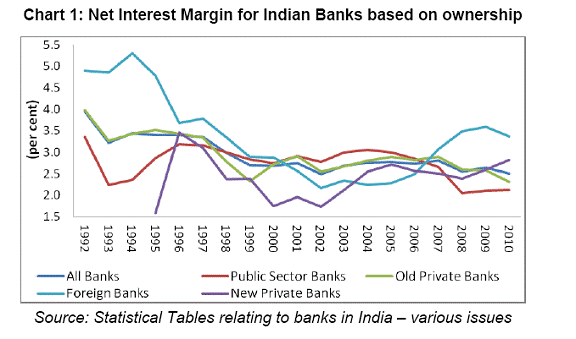The dilemma over Net Interest Margin (NIM) for the Banking sector
We may be critical about the high interest rates of the banking sector in India, but the Net Interest Margin (NIM) of banks has actually weakened ever since the crisis. NIM is a measure of the profitability of a bank and is calculated as the ratio between difference in the interest income earned on loan advances and average earning assets of the bank, and the amount of interest paid to depositors.
For example, assume a bank pays its depositors 8% interest rate, and charges 10% from borrowers. Now, even with this 2% nominal difference, the net profitability of a bank would vary if numbers of depositors or borrowers vary over time. The more the depositors, the more the bank has to pay while more borrowers mean more income for the bank. Bank managements try to take investment decisions that would maximize their profits (income from borrowers – interest paid to depositors) and NIM essentially measures this profitability.
The ongoing crisis has affected bank earnings in a big way. Rise in NPAs and slower off take of loans have resulted in total income earnings of banks taking a big hit. This in turn is affecting NIM in a big way. A study by the RBI clearly shows how the NIM has drastically fallen for Indian banks across all categories as a result of the global crisis.

SOURCE: Net Interest Margin, Financial Crisis and Bank Behavior: ,Experience of Indian Banks
This puts the banking sector in a Catch 22 situation over interest rates. They are now under pressure to offer lower interest rate to depositors and charge higher interest rates from borrowers. The interest rates on fixed deposits today (around 9.5% approximately) do not cover the high inflation rate which still hovers in double digits. This essentially means that depositors actually face a loss on their deposits. On the other hand, higher interest rate on borrowing has already reduced loan off-takes and raised NPAs across all banks.
This is more of a structural problem pertaining to the large institutions that banks operate as. Banks are behemoths that accumulate large base of deposits and then diversify their portfolio over large spreads of lending. Till the financial crisis hit, the scale of operations was assumed to be an assurance of safety and the notion “too big to fail” held sway. Post crisis, this notion has not only been thoroughly debunked, but has actually been turned on its head.
The big scale and spread that was supposed to minimize exposure risks of financial institutions is today acting as the means of transmitting the crisis from one set of borrowers to the other. If a big corporation defaults on a big loan, its puts too much pressure on the bank’s NIM which in turn is percolated to small scale borrowers like individuals seeking a home loan or an auto loan.
A possible solution to this dilemma could be smaller, focused, micro level financing systems like P2P Lending. A smaller scale of operation with lower overhead costs, a smaller spread of exposure limiting risk transmission, greater flexibility at individual borrower/ lender level to pick and choose , are some of the advantages that small scale informal lending has always had over its large institutionalized counterparts. P2P essentially offers these advantages but in a structured and systematic manner that not only helps raise its acceptance, but also gives it wider reach within a focused group. With traditional financial institutions like banks struggling to shake off the aftermaths of the great crisis, it is possible for innovative alternatives like P2P to make a mark in today’s troubled times.
Related Articles
-
Why Banks won’t lend to applicants with Credit Score of -1
Apr 21, 2014
-
Banks and the High Interest Rate regime
Mar 28, 2014
-
5 Hidden costs in your 'Interest free' loan
Apr 03, 2014
